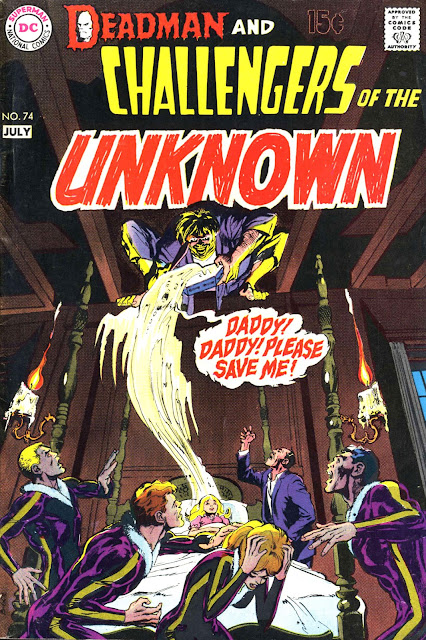Dec 5th 2020 Advent Calendar
A beautiful woman lies at an uncomfortable angle amongst the bodies and debris of a savage sworded battle--
As assorted warriors and beast-like figures charge furiously forward, demonic-looking creatures swoop in from the darkening sky--
And at the centre of the frame, a long-haired, heavily-armed barbarian twists his muscular body round to face an axe-wielding assailant and screams defiantly, "TO THE DEATH!"
Yes, it's "NEW!", it's the "first time in comic book form!", it can only be "The coming of Conan!" With a cover date of October 1970, Marvel's CONAN THE BARBARIAN #1 brought Robert E. Howard's much-loved Sword and Sorcery character to a whole new audience, courtesy of writer Roy Thomas and of course British artist Barry Windsor-Smith.
This cover successfully showcases all the key elements of Conan's fictional world-- the rippling muscles, the violent gory battles, the scantily clad females. It's a raw, dynamic tableau, the muted background colours helping the triangular shape formed by the figures in the foreground of Conan, the woman and the axe-wielder's hands. Smith's decision to make Conan's eyes appear to be looking off into the distance instead of at the axe-man or even out at the reader creates the impression that he can see hoardes of assailants beyond the frame, heightening the sense of peril.
Marvel's digital version boasts rich new colours broadly faithful to the original (unlike DC's updated offerings), though it's undeniably brighter allowing the detail to be more easily appreciated. Whether you prefer this or the original is going to be a matter of personal taste--
The collected edition also boasts this brown-tinted monochrome version, the absence of colour enabling perhaps a closer look at Smith's beautifully precise brush-work--
Then there's the collection's completely restyled colouring for its cover page, in which the flying green demons have now been made red to match their colouring in the story itself. Some might enjoy seeing the changes. I don't. The three figures in the triangular shape stand out less effectively, have been rendered purple, almost the same colour as the ground and not sufficiently in contrast to the blue figures behind them. It's an odd change, the modern colourist clearly falling victim to common conceit that they can improve upon something which didn't need improving on. The dabbling with the colours of the sky doesn't help either.
To my mind the impact of the comic's cover lies in a very simple technique employed by artist Smith, and it's one which aspiring artists can learn from very easily, one which gives the cover its dynamic impact-- he draws Conan's head facing in a different direction to the rest of his body. It's as simple as that-- by drawing in this case his body facing to the right of the frame and his head twisted round to the left Smith creates the illusion of movement. If his head had been facing right too, then Conan would look like he's standing still, albeit in an awkward pose. It really is a simple trick, but one that always works and is very popular when creating a dynamic cover image. Here's the same technique being used with Batman earlier this year by Ryan Benjamin--
And this is a good example of Judge Dredd by Cliff Williams and Dylan Teague from just a few months ago--
This is a lovely extreme example from Frank Miller's reissue of the RONIN TPB--
Returning to Conan, I have just started reading this title for the first time. Until now my only exposure to the character, like so many other Marvel characters, has been the movie which I saw in a Paris cinema on its original release some months before it was released in the UK. Needless to say I shall soon be writing about my thoughts on reading the comic version's earliest issues.
You can find Day 4 of my Advent Calendar here--












Looking forward to your posts on the early Marvel Conan issues, Andrew! My own first such will be coming up towards the end of January, as issue #4 was the first one I bought off the racks.
ReplyDeleteRegarding the differences in coloring between the original and current digital editions, I feel fairly certain that, when it was new, the original looked much more like the digital than it does today. Certainly the areas colored white in the digital were white in the original, rather than the creamy shade that has been wrought by age.